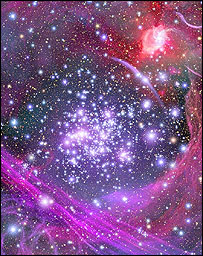
The Arches cluster lies near the centre of our
galaxy |
An
upper limit has been placed on how heavy stars can get: they are
constrained to about 150 times the mass of our own Sun, new research
claims.
It had previously not been possible to determine this limit or
even to say whether stars were constrained in mass.
But Donald Figer used the Hubble Space Telescope to look for
massive stars in the Arches star cluster, which is close to the
centre of our own galaxy.
Details of the research are published in the latest issue of
Nature.
 |
 There is a heavy burden in making this
kind of claim, because it means that you have to go out and
potentially look at every star in the Universe There is a heavy burden in making this
kind of claim, because it means that you have to go out and
potentially look at every star in the Universe 
|
Dr Figer, of the Space Telescope Science Institute (STSCI) in
Baltimore, Maryland, chose the Arches cluster because it is young
enough to expect massive stars but old enough that the cloud of
material in which it was "born" has disappeared, giving astronomers
a clear view.
The dense cluster is sufficiently large that, statistically
speaking, stars up to 500 times our Sun's mass should be found
there. But the astronomer turned up no stars bigger than about 130
solar masses.
The researcher concludes, on probability, that 150 solar masses
is the upper limit for stars.
And the observations further indicate that there is only a one in
100 million probability that stars have no upper limit to their
mass.
Scrutinising claims
"There is a heavy burden in making this kind of claim, because it
means that you have to go out and potentially look at every star in
the Universe," Dr Figer told the BBC News website.
"That's not going to happen. But the least we can do is be aware
of any claim of a star being above the limit."
Dr Figer added that previous claims for stars above 150 solar
masses had not stood up to scrutiny.
"For instance, there was an object called R136. We used to think
it was a few thousand solar masses. Now we know it's composed of
hundreds of stars," he explained.
Professor Janet Drew, of Imperial College in London, UK,
commented that the research was a "nice piece of work" with a very
interesting interpretation.
"Yes, there are loopholes, but I think that the loopholes are not
that large," she explained.
Other researchers have pointed out that the cluster could once
have hosted more massive stars that have since exploded, and whose
remnants could be lurking as black holes.
Further confirmation
If confirmed by further work, the finding of an upper limit for
star mass would have important implications for our understanding of
the structure of the Universe.
The upper limit of stars was thought to be related to how
enriched they were with heavy elements such as iron. But the new
research suggests this may not be the case.
It also questions whether a quantity called radiation pressure is
the physical mechanism that stops stars from becoming too heavy.
When radiation pressure exerted by a star reaches a certain level,
it was thought to stop the incorporation of any new matter from the
surrounding stellar "nursery" cloud.
Dr Figer said he wanted to look at whether some massive stars
were actually binary stars (composed of two stars).
"If all those stars in the Arches cluster that are 130 solar
masses are binary, it would mean the upper limit might actually be
less. But that's highly unlikely," he explained.
The researcher has just been given a grant by the US space agency
(Nasa) to expand the work. But he admits the decision to de-orbit
the Hubble Space Telescope means the investigation will probably
have to be conducted with haste.
